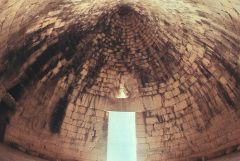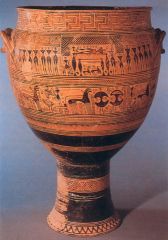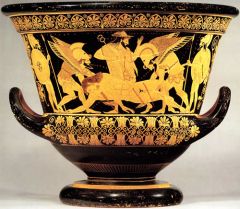![]()
![]()
![]()
Use LEFT and RIGHT arrow keys to navigate between flashcards;
Use UP and DOWN arrow keys to flip the card;
H to show hint;
A reads text to speech;
20 Cards in this Set
- Front
- Back

|
Toreador Fresco Minoan 1450-1400 BC
•bulls sacred to Minoans painting shows a ritual involving acrobats jumping over bull women are lighter skinned true fresco bull as symbol of virility |
|

|
Tholos, Treasury of Atreus Mycenean c. 1300-1250 BC
beehive shaped tomb Greeks mistook for the treasury of Atreus, father of Agamemnon & Menelaus dome formed by series of corbel vaults weight of stone holds it together – no cement biggest dome until Romans build Pantheon |
|

|
Krater from Dipylon Geometric c. 740 BC
• geometric patterns give period its name • meander or key pattern at top • human figures, but given geometric shapes • central figure is the dead man on his bier |
|

|
Lady of Auxerre Geometric 650-625 BC
• period in which Greek trade with near East and Egypt influences art • moving toward naturalism but still enamored of geometric shapes • triangular flat-topped head; geometric pattern on skirt • clothed female figure like all Kore, no headdress suggests not a goddess • painted using encaustic method: pigment mixed with hot wax |
|

|
Kouros from Anavysos Archaic c. 530 BC
• “orientalizing” influence of Egypt apparent in stiff posture and hairstyle • unlike Egyptian statuary because it is freed of the block • like Egyptian statuary in that figure is idealized • archaic smile • may have been either a funerary monument or a votive offering |
|

|
Pediment/Temple of Artemis (Medusa) Archaic 550 BC
• Medusa = guardian figure • triangular shape of pediment used awkwardly • Medusa dominates space – 9 feet tall • Medusa nearly free-standing |
|

|
Panathaneic Prize Amphora Archaic 530 BC
• black figure vase • artist = Euphiletos • awarded to winner of athletic event at Panathenaic Festival •Panathenaic Festival held to celebrate new dress for cult statue of Athena • vase features sprinters in action |
|

|
Death of Sarpedon Krater Archaic 515 BC
• red figure vase • artist = Euphronios • shows Trojan hero Sarpedon, son of Zeus • Hermes as psychopompos behind figure, Sleep and Night at each end |
|

|
Kritios Boy Classical c. 480 BC
• introduction of contrapposto pose • body shifting around central axis (the waist) and one knee bent • technically still a kouros • idealized, athletic body • no archaic smile or orientalizing qualities |
|

|
Diskobolos Myron Classical c. 450 BC
• illustrates Greek ideal of arête, or balance • moment before release of discus = controlled energy • expresses control of mind over body • shows admiration for physical perfection • Roman marble copy of original Greek bronze |
|

|
Parthenon Kallikrates & Iktinos Classical c. 447-438 BC
• like the Doryphoros, perfectly proportioned • housed a 38-foot chryselephantine statue of Athena • demonstrates alexomata – “corrections” to the base and columns to create an optical illusion of perfection • frieze went all the way around the inner building depicting Athenian procession • outside entablature showed metopes with a centauromachy • pediments showed birth of Athena and judgment between Athena & Poseidon |
|

|
Temple of Athena Nike Classical 427-424 BC
• architect = Kallikrates • smallest building on the Acropolis • Nike = Victory • at one time had a parapet going around edge |
|

|
Nike Adjusting her Sandal Classical 410 BC
• relief from parapet of Temple of Athena Nike • describes balance, control and grace • modeling of body and fall of drapery shows skill of sculptor |
|

|
Grave Stele of Hegeso Classical 400 BC
• aesthetically: balance, symmetry, beauty • technical mastery of draperies, hands, etc. • contextually: women trapped in home + presence of slave • 3rd type of grave marker (first vases, then kouros, then stele) |
|

|
Aphrodite of Knidos Late Classical 350-340 BC
• sculptor = Praxiteles • first instance of a female nude in Greek art (other than prostitutes or slaves) • she is about to bathe; unintentionally erotic |
|

|
Apoxyomenos Lysippos Classical c. 330 BC
• shows an ordinary activity – scraping oil off body after a workout • different canon of proportions from Polykleitos – smaller head, longer legs & body • not as idealized or muscled as Doryphoros • not a heroic pose, no longer expressing mental dominance over body |
|

|
Dying Gaul Hellenistic 230-220 BC
• from Pergamon altar • shows death with dignity; accords enemy nobility and strength • dramatic subject with full emotion intended to draw viewer in • Gallic torque (braided gold band) around his neck (not a rope, sorry) • realistic |
|

|
Nike of Samothrace Hellenistic 190 BC
• landing on prow of ship • commemorates victory of Athenians as Salamis • realistic depiction of movement (the wind’s) • exception handling of modeling and drapery |
|

|
Old Market Woman unknown Hellenistic 150-100 BC
• shift in subject from gods, goddesses, the wealthy to impoverished woman • realism in terms of physical attributes (wrinkles, etc.) • also realistic in terms of psychological qualities – weariness, depression |
|

|
Laocoon Rhodes Sculptors Hellenistic c. 1 AD
• narrative: story of Trojan priest who warned fellow citizens • Apollo sent poisonous sea snakes to strangle Laocoon and his sons • expressive: shows figures’ agony in expression and physical struggle • admired and copied by Michelangelo |

